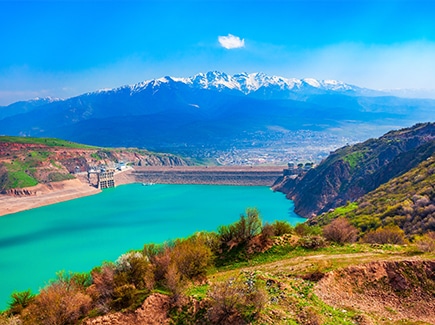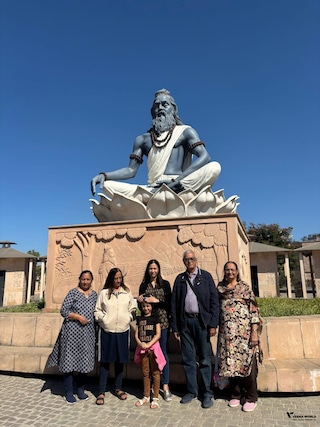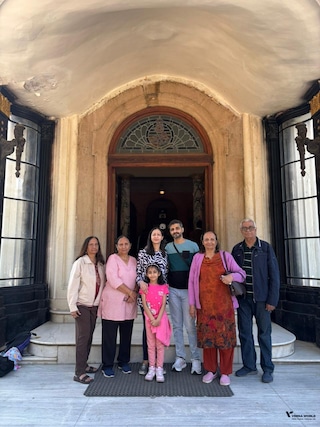Published in the Sunday Mumbai Samachar on 21 April, 2024
Today, the Pyramids of Giza stand majestically on the outskirts of Cairo in Egypt. They are on everyone’s travel bucket list and we have grown up watching a number of documentaries about these Pyramids on National Geographic and Discovery. These monumental structures built more than four and a half millennia ago, continue to captivate and mystify visitors from around the globe.
The Pyramids of Giza, comprising the Great Pyramid of Khufu, the Pyramid of Khafre, and the Pyramid of Menkaure, along with the enigmatic Sphinx, are not only the pinnacle of ancient Egyptian architectural achievement but also the last surviving members of the Seven Wonders of the Ancient World. So today, let’s travel to the heart of Egypt's enduring legacy and delve into why these ancient structures have fascinated humanity for centuries. First, let’s actually find out how they may have been built because the Pyramids of Giza have been the subject of countless studies, explorations, and debates, yet they continue to hold secrets that are yet to be uncovered.
Let’s start with who built them and when. The Pyramids of Giza were constructed during Egypt's Fourth Dynasty in the Old Kingdom, a period of prosperity and artistic flourishing. The timeline places their construction roughly between 2580 and 2510 BCE. The most ancient and largest among them, the Great Pyramid of Khufu, is believed to have been completed around 2560 BCE. The Pyramid of Khafre followed it and then the Pyramid of Menkaure, each serving as an eternal resting place for the respective pharaohs after whom they are named.
For centuries, the construction of the Pyramids of Giza has puzzled historians and engineers alike. The ancient Egyptians left no records detailing the methods used to build these colossal structures, leading to a myriad of theories. The most widely accepted theory suggests that the pyramids were built using a system of ramps to transport the massive limestone blocks into place. Variations of this theory propose different configurations of the ramps, from straight ramps extending from the quarry to the construction site, to zigzagging or circular ramps that allowed workers to haul the stones upward with less effort. Recent discoveries, such as remnants of a workers' village and a system of waterways, suggest a highly organized labour force sourced from skilled workers and not slaves, as previously thought.
The Great Pyramid of Khufu stands as the largest in Giza, originally reaching a height of 146.6 meters (481 feet), though now slightly shorter due to the loss of its outer casing stones. It was constructed with an estimated 2.3 million blocks of stone, each weighing an average of 2.5 to 15 tons. The precision with which these blocks were cut and placed is one of the pyramid's most baffling aspects, with joints between stones being nearly imperceptible.
The Pyramid of Khafre, while slightly smaller than Khufu's, appears taller from certain angles due to its higher elevation on the plateau. It is distinguished by the remaining casing stones at its peak, giving a glimpse into how the original pyramids would have looked with their smooth, gleaming surfaces. The complex also includes the Great Sphinx, a colossal statue with the body of a lion and the head of Pharaoh Khafre, guarding the pyramid and serving as a symbol of royal power.
And the smallest of the three, the Pyramid of Menkaure, marks a departure in size but not in significance. It features three smaller queen's pyramids and a more complex mortuary temple, indicating evolving architectural styles and religious practices.
Along with the three Pyramids, the Sphinx stands as the oldest known monumental sculpture in Egypt. Carved from a single block of limestone, it is believed to represent the face of Pharaoh Khafre, serving as a guardian of the plateau and a symbol of royal authority.
Speaking of these pyramids, it is incredible to note that the layout of the pyramids was meticulously planned. The base of each pyramid was laid out in a perfect square, with each side oriented to face one of the cardinal points. This level of precision required an advanced understanding of geometry and the use of tools like the merkhet (an ancient Egyptian timekeeping instrument) and bay (a type of sighting tool) to achieve accurate alignment. Now that we have spoken of how they may have been built, let’s look at a few reasons why they were built.
Royal Burials: The primary purpose of the pyramids was to house the remains of the pharaohs after their deaths. Pharaohs were believed to be divine rulers, and their tombs were constructed to ensure a safe journey to the afterlife. The pyramids contained burial chambers, sarcophagi, and various items and treasures that the pharaoh might need in the afterlife.
Spiritual and Religious Significance: The construction of pyramids was deeply rooted in the religious beliefs and cosmology of ancient Egypt. The pyramids symbolized the pharaoh's ascent to the heavens and their transformation into a god-like figure after death. The pyramid shape represented the rays of the sun, and the pharaoh's soul was believed to follow the sun god Ra on its daily journey.
Political and Cultural Symbolism: Pyramids were not only functional structures but also symbols of the pharaoh's power, wealth, and prestige. Their construction showcased the ruler's ability to mobilize resources, labor, and engineering expertise. They were a tangible representation of the ruler's divine status and authority.
Social and Economic Role: The construction of pyramids required a vast labour force, including skilled architects, engineers, and labourers. These projects created employment opportunities and helped sustain the economy by fostering trade and agriculture.
Commemoration of Pharaohs: The pyramids also served as lasting monuments that commemorated the pharaohs and preserved their memory for eternity. Inscriptions and hieroglyphics inside the pyramids provided information about the pharaoh's achievements and lineage.
All in all, the construction process was surrounded by religious rituals and ceremonies, and the pyramid complexes included temples, causeways, and other structures for use in funerary rituals and offerings to the deceased pharaoh. Overall, the Egyptian pyramids were multifaceted structures that played a central role in ancient Egyptian culture, religion, and society, and even today, they continue to fascinate and intrigue people from around the world to this day.
















































Post your Comment
Please let us know your thoughts on this story by leaving a comment.